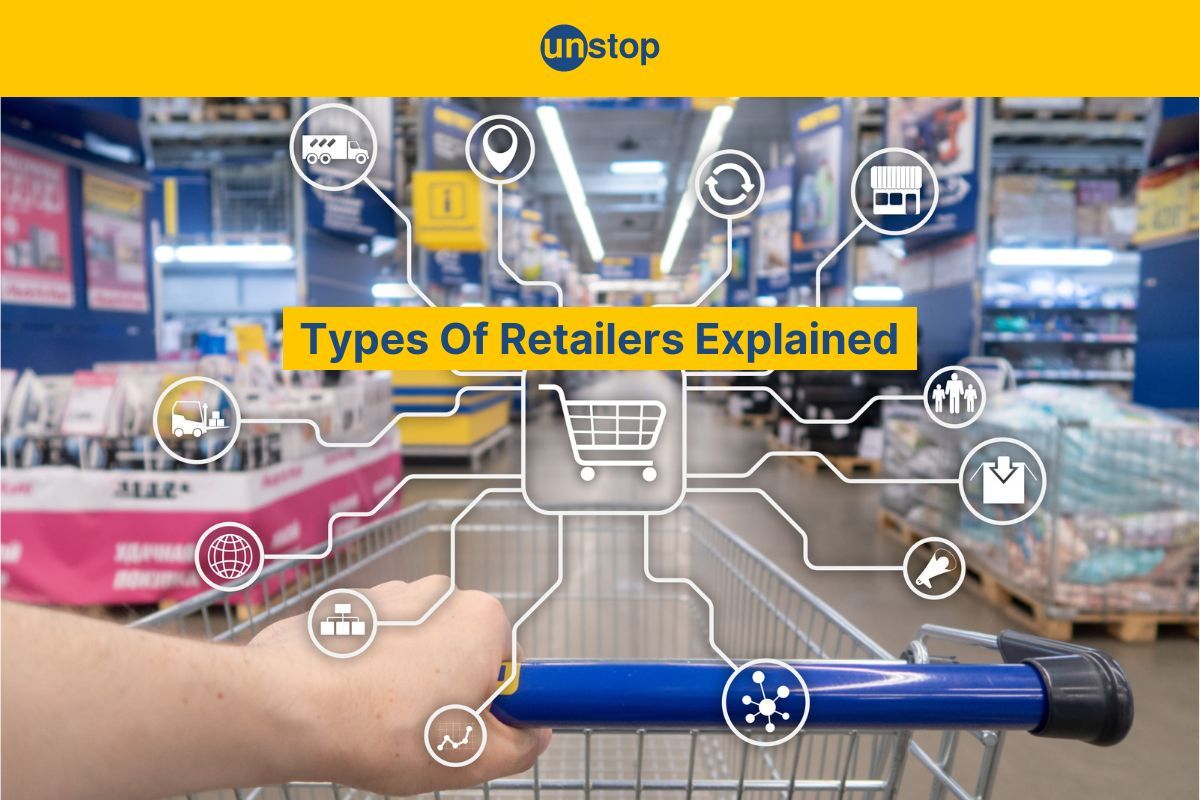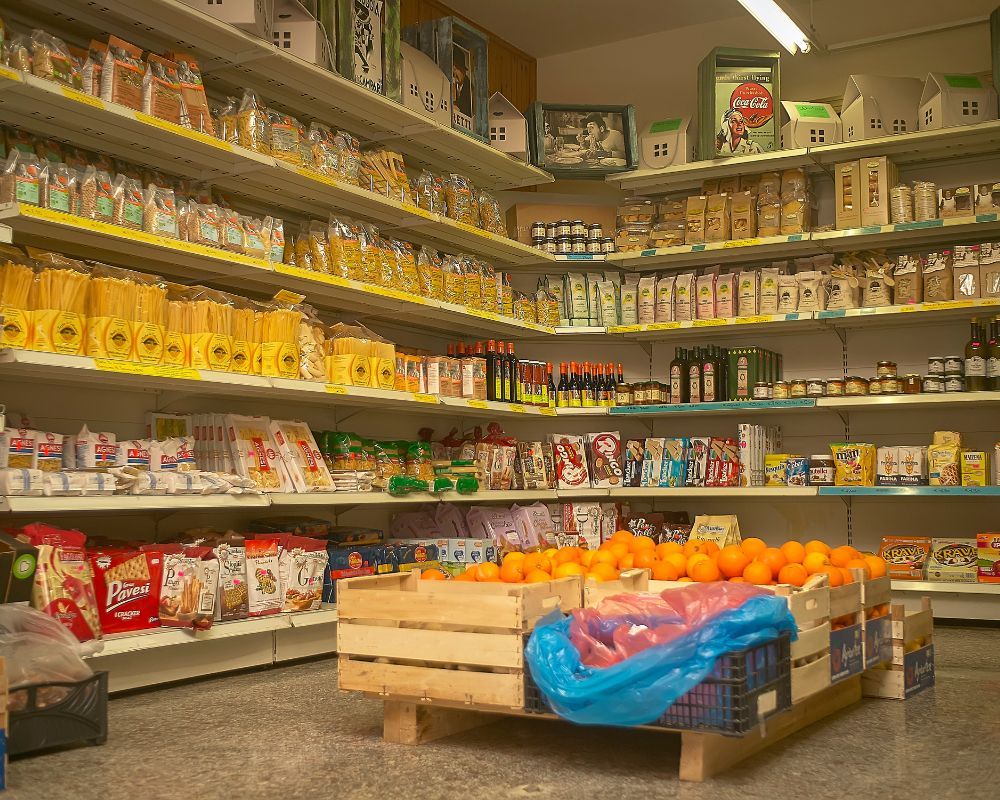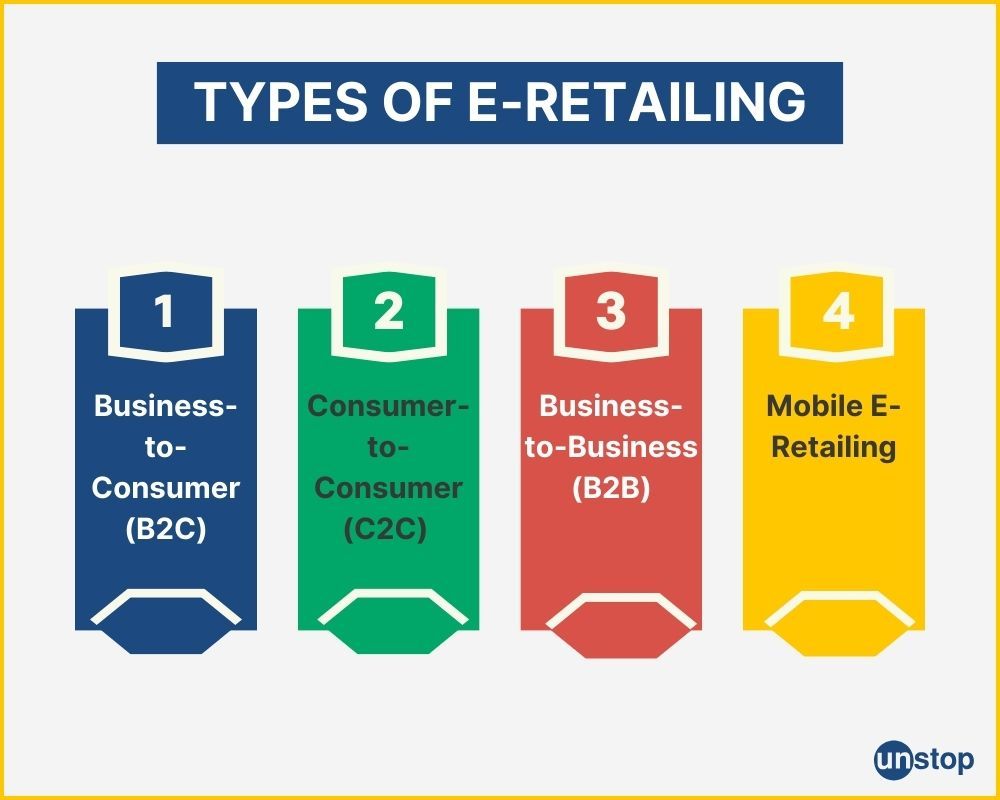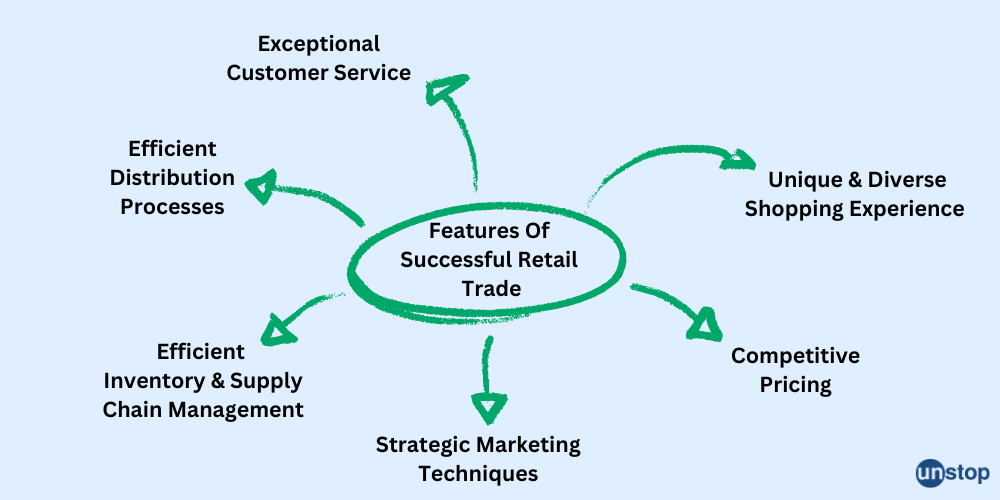- Retailers & Their Roles
- Types Of Retailers
- Types of E-Retailing
- Role & Functions Of Retail Environments
- Specialty, Discount & Warehouse Retailing
- Difference Between Supermarkets & Hypermarkets
- Store-Based Vs Non-Store Based Retailing Methods
- Essential Features Of Successful Retail Trade
- Future Of Retailing & Evolving Consumer Trends
- Conclusion
- Frequently Asked Questions (FAQs)
Types Of Retailers - Definition, Role, Examples

The retail industry is an essential component of the global economy, with businesses directly selling products or services to consumers. Understanding the various types of retailers is imperative for both customers and companies alike.
By exploring different retail categories, individuals can make informed purchasing decisions, while businesses can tailor their strategies to meet customer demands. In this article, we will delve into the diverse world of retailing.
Understanding Retailers & Their Roles
Retailers are businesses or individuals that sell goods or services directly to consumers, acting as the final link in the supply chain from manufacturers to consumers. They purchase products in bulk from producers or wholesalers and sell them in smaller quantities to end users, thereby playing a crucial role in making goods available to the general public.
Retailers operate through various formats including brick-and-mortar stores, online platforms, or a combination of both, catering to a wide range of consumer needs and preferences.
The importance of retailers extends beyond mere distribution; they also contribute to the economy through job creation, and they often serve as the primary interface between the product and the consumer, providing valuable feedback to manufacturers and influencing product development and marketing strategies. Let's understand their role in detail.
Retailers Acting As Intermediaries
Retailers act as middlemen, connecting manufacturers with consumers. They purchase goods from manufacturers in bulk and then sell them in smaller quantities to individual customers.
By acting as intermediaries, retailers simplify the distribution process for manufacturers, bridging the gap between production and consumption by making products accessible to consumers through their physical stores or online platforms.
Meeting Consumer Needs
Catering to a diverse range of products or services that meet consumers' demands is one of the primary goals of retailing. Different types of retailers specialize in specific product categories or serve niche markets.
Retailers often tailor their offerings based on market trends and consumer feedback. They constantly analyze customer preferences and adapt their product assortment accordingly. This ensures that they stay relevant in a dynamic marketplace where consumer needs are constantly evolving.
Job Creation & Economic Growth
The retail industry is a significant contributor to job creation worldwide. From sales associates at brick-and-mortar stores to warehouse workers fulfilling online orders, retailers employ millions of people globally.
The growth of retail businesses stimulates economic development by generating revenue for both local communities and national economies. Retail establishments pay taxes that fund public services such as infrastructure improvements, education programs, and healthcare initiatives.
When consumers have access to a variety of products and services from different retailers, they are more likely to spend their money, thus stimulating economic activity.
Types of Retailers
There are different types of retailers. Let us go through some of the important types of retailers in detail:
1. Department Stores
Department stores are one of the many types of retailers that exist in the market. These stores provide products that cater to various consumer preferences and demands. Department stores aim to provide shoppers with a comprehensive shopping experience all under one roof, including clothing, accessories, home appliances, and electronics.
Independent retailers who prioritize unique offerings might find success by collaborating with department stores that have established customer bases. Examples of departmental stores include Shoppers Stop, Lifestyle.
2. Specialty Stores

Specialty stores are another type of retailer that aims at a specific niche or product category. These stores specialize in offering a curated selection of retail merchandising tailored to meet the needs and interests of a particular target audience.
For example, there are specialty stores selling product categories such as fashion, electronics, or footwear. Example: Tanishq (jewelry), Croma (electronics).
By focusing on a specific area, these retailers can provide expert knowledge and an extensive assortment within their chosen field. Service retailers such as salons or repair shops would benefit from partnering with specialty stores that cater to similar customer demographics.
3. Convenience Stores

Convenience stores, as the name suggests, prioritize convenience for consumers. They typically operate in easily accessible locations such as gas stations or busy urban areas. These retailers stock everyday essentials like snacks, beverages, toiletries, and other items that people may need on the go or at odd hours.
Convenience stores often have extended operating hours compared to other retailers, making them convenient options for last-minute purchases or emergencies. By analyzing consumer preferences and shopping behaviors associated with different retail types, businesses can make informed decisions about partnerships and marketing campaigns.
4. Itinerant Retailers

Itinerant retailers are a unique type of business that operates on the move, often setting up temporary shops or stalls in different locations. These retailers do not have a fixed physical store and instead travel from place to place, selling their products or services to customers.
Itinerant retailers can be found in various industries, such as food vendors at street markets, mobile fashion boutiques, or even traveling repair services. Itinerant retailers often bring a sense of excitement and novelty to the areas they visit as customers eagerly await their arrival to explore their offerings.
Apart from the above, other types of retailers include:
- Supermarkets: Retailers primarily selling food and beverages, often with a focus on household essentials. Example: Big Bazaar, Reliance Fresh
- Discount Stores: Retailers offering products at lower prices, often by buying in bulk or offering limited service. Example: DMart, Vishal Mega Mart
- E-commerce Retailers: Online stores that sell products through digital platforms without physical storefronts. Example: Flipkart, Amazon
- Warehouse Clubs: Membership-based retailers selling bulk products at discounted prices, typically targeting large households or small businesses. Example: Metro Cash & Carry, Best Price (Walmart India)
- Outlet Stores: Retailers selling products at reduced prices, often clearing inventory from past seasons or surplus stock. Example: Brand Factory, Nike Factory Outlet.
Each retailer type caters to different consumer needs and shopping experiences.
Types of E-Retailing
E-retailing, also known as online retailing, refers to the selling of goods and services through the use of the internet. It has gained immense popularity in recent years due to its convenience and accessibility. There are several different types of e-retailing, each offering unique features and benefits.

Let's explore some of the most common types in detail:
Business-to-Consumer (B2C) E-Retailing
This is the most common type of e-retailing. In this type of e-retailing, businesses sell their products or services directly to individual consumers. B2C e-retailers typically have websites or online platforms where customers can browse and purchase items.
Examples include online marketplaces like Amazon, clothing retailers like ASOS, and electronics stores like Best Buy.
Consumer-to-Consumer (C2C) E-Retailing
In C2C e-retailing, individual consumers sell products or services directly to other consumers through online platforms or marketplaces. Online platforms and marketplaces act as intermediaries, facilitating transactions between buyers and sellers.
Popular C2C e-retail platforms include eBay and Craigslist. This type of e-retailing enables individuals to sell used or unwanted items, creating a marketplace for second-hand goods.
Business-to-Business (B2B) E-Retailing
B2B e-retailing involves businesses selling products or services to other businesses through online channels. This type of e-retailing is commonly used for wholesale transactions, where businesses purchase goods in bulk from suppliers.
B2B e-retailers often have specialized platforms or websites that cater specifically to other businesses' needs. Examples include Alibaba and ThomasNet.
Mobile E-Retailing
With the increased usage of smartphones, mobile e-retailing has become a popular trend. E-mobile retailing refers to the buying and selling of products or services through mobile applications or mobile-optimized websites.
Mobile e-retailing offers convenience and flexibility, allowing consumers to make purchases on the go.
Role & Functions Of Retail Environments
Different retail environments offer unique shopping experiences, such as malls, shopping centers, and high streets. These environments provide a variety of options for consumers to explore and make purchases.
Malls
In malls, shoppers can find a wide range of retail stores under one roof. From clothing boutiques to electronics outlets to specialty shops, malls cater to diverse consumer preferences. This variety allows shoppers to compare products and prices conveniently in one location.
Malls often host promotional events or product launches that allow retailers to engage directly with customers. These events create opportunities for brand exposure and customer interaction.
Shopping Centers
Shopping centers also offer an array of retail outlets. These centers typically consist of multiple standalone stores arranged in a complex or strip mall format. They often feature anchor stores like supermarkets or department stores that attract foot traffic and contribute to the overall shopping experience.
Shopping centers essentially serve as platforms for marketing initiatives.
High Streets
High streets are known for their bustling atmosphere and mix of businesses. With their storefronts lining the main street, these areas are popular among pedestrians who enjoy browsing through different shops while enjoying the vibrant surroundings.
High streets often showcase local businesses alongside well-known brands, providing shoppers with both familiar options and unique finds. High streets contribute significantly to brand recognition as well.
By having a physical presence on busy streets, retailers can capture the attention of passersby through eye-catching displays or window arrangements that reflect their brand identity.
Also Read: What Is Visual Merchandising?
Convenient Locations
Retail environments are strategically located in business districts, traditional locations, or residential areas to maximize convenience for consumers. Malls are commonly situated near major transportation hubs or highways, making them easily accessible for shoppers from various locations.
Shopping centers are often found in suburban areas, providing convenience to residents who prefer to shop closer to home. These centers serve as community hubs, offering a range of retail options without the need for lengthy commutes.
High streets are typically located in city centers or urban neighborhoods, making them easily reachable by public transportation or within walking distance for residents.
The accessibility of retail stores encourages spontaneous shopping trips and supports local businesses.
Specialty, Discount & Warehouse Retailing
Let us study in detail three notable retailing methods used in marketing by retailers, namely, Specialty Retailing, Discount Retailing, and Warehouse Retailing:
Specialty Retailing
Specialty retailers, as the name suggests, focus on catering to niche markets that offer specialized products or services. These retailers understand the unique needs and preferences of their target customers and curate their inventory accordingly.
Customers can find a diverse range of products within their specific area of interest while shopping at a specialty store. Whether it's a hobby or a particular lifestyle choice, specialty retailers provide a curated selection that meets the needs of enthusiasts.
Discount Retailing
Discount retailers are known for providing affordable prices to consumers. They achieve this by offering lower-cost alternatives or bulk purchasing options.
Discount stores aim to attract price-conscious shoppers who are looking for good deals without compromising on quality.
Discount retailers often have large buying power due to their scale of operations and negotiate favorable terms with suppliers. This allows them to offer products at discounted prices compared to other retail establishments.
Customers can find everyday items like groceries, household goods, clothing, and electronics at lower costs in these stores.
Warehouse Retailing
Warehouse retailing takes affordability one step further by offering discounted prices for an extensive range of products through large-scale operations. Warehouse retailers operate on the principle of buying products in bulk and giving savings to customers.
These big-box stores stock everything under one roof, from groceries and home appliances to furniture and electronics. By eliminating fancy displays and focusing on efficient logistics, warehouse retailers minimize overhead costs and maximize value for customers.
Shoppers who prefer convenience and variety appreciate warehouse retailing as they can fulfill multiple shopping needs in one place while enjoying significant cost savings.
Difference Between Supermarkets & Hypermarkets
Supermarkets and hypermarkets are two popular types of retailers that offer convenience and a wide selection of products. Let's take a closer look at what sets them apart.
Supermarkets
Supermarkets are large self-service stores that cater to the everyday needs of consumers. They offer food items, including fresh produce, dairy products, meat, and pantry staples. Example: Reliance Fresh.
In addition to groceries, supermarkets also provide household items like cleaning supplies, personal care products, and pet supplies. One of the key advantages of shopping at a supermarket is the convenience it offers. With everything under one roof, customers can easily find all their essentials in a single visit.
The layout of a supermarket is designed to help shoppers navigate through various aisles efficiently. From checkout counters to well-organized shelves, supermarkets strive to make the shopping experience smooth and hassle-free.
Hypermarkets
Hypermarkets take the concept of supermarkets to another level by combining groceries with general merchandise under one roof. These stores are even larger than supermarkets and often feature departments dedicated to electronics, clothing, home goods, furniture, and more. Example: SPAR Hypermarket.
The primary appeal of hypermarkets lies in their vast selection of products across different categories. Customers can not only purchase their weekly groceries but also explore other non-food items during the same visit. The availability of multiple departments within a hypermarket allows shoppers to fulfill diverse needs without having to visit separate stores or shopping centers.
A hypermarket is an attractive options for those looking for variety and convenience in one place. It emphasizes self-service shopping, where customers can browse through aisles independently or use convenient shopping carts for larger purchases.
Store-Based Vs Non-Store Based Retailing Methods
Let us study the key differences and advantages of store-based vs non-store based retailing:
Stored-Based Retailing
Store-based retailing is a traditional method where customers visit physical locations to browse and purchase products. These retail stores can take various forms, such as department stores, specialty stores, or convenience stores. Customers have the opportunity to interact with the products, try them out, and receive assistance from sales associates.
Non-Stored-Retailing
On the other hand, non-store-based retailing methods have gained popularity in recent years. These methods include e-commerce, mobile commerce, and direct selling. With e-commerce, customers can shop online through websites or mobile apps without physically visiting a store.
Mobile commerce allows customers to make purchases directly from their smartphones or tablets. Direct selling involves personal interactions between sales representatives and customers in settings like homes or parties.
Advantages Of Store-Based Retailing & Non-Store Based Retailing
Both store-based and non-store-based retailing methods have their advantages and cater to different consumer preferences.
| Store-Based Retailing | Non-Store Based Retailing |
|---|---|
|
Physical Experience Customers can touch, feel, and try products before making a purchase, enhancing the shopping experience. |
Convenience Shoppers can buy products anytime and anywhere without the need to visit a physical store, offering ultimate convenience. |
|
Immediate Gratification Purchases are made and received instantly, satisfying the immediate need for the product. |
Wider Selection Offers access to a broader range of products that may not be available in physical stores. |
|
Customer Service Direct interaction with sales staff can provide personalized advice, immediate assistance, and a better service experience. |
Price Comparisons Easier to compare prices and find the best deals across different platforms without geographical limitations. |
|
Brand Experience Stores can offer a unique brand experience through their layout, design, and ambiance, which can reinforce brand loyalty. |
Privacy Shopping can be done in the privacy of one's home, which is particularly appealing for personal or sensitive purchases. |
|
Social Interaction Provides a social experience as customers can shop with friends or family, making it a social activity. |
Lower Costs Often lower operational costs than physical stores, which can translate to competitive pricing for consumers. |
|
Immediate Issue Resolution Problems or concerns can be addressed on the spot, leading to instant customer satisfaction. |
Accessibility Especially beneficial for people who live in remote areas or have mobility issues, making shopping accessible to more people. |
Essential Features Of Successful Retail Trade

Exceptional Customer Service
Successful retailers understand the importance of delivering exceptional customer service. They know that satisfied customers are more likely to become repeat customers and recommend their business to others.
By providing personalized assistance, addressing customer concerns, and going above and beyond to meet their needs, successful retailers build strong relationships with their clientele.
Unique & Diverse Shopping Experience
Creating unique and memorable shopping experiences is another key feature of successful retail trade. Top retailers understand that shopping is not just about purchasing goods but also about the overall experience.
Offering a wide range of products is another characteristic of successful retail businesses. Whether it's a clothing store with a diverse selection of styles or a sporting goods shop with equipment for various sports activities, these retailers cater to different customer preferences by providing an extensive product range.
Efficient Inventory Management & Supply Chain Management
Efficient inventory management and supply chain management are crucial for success in retail trade. Successful retailers carefully monitor their merchandise levels, making sure that they have sufficient stock to meet demand without overstocking or running out of popular items.
By implementing effective systems for tracking sales volume, analyzing trends, and forecasting future demand, these retailers can optimize their product range and ensure a steady flow of goods.
Strategic Marketing Techniques
To be successful in retail business, retailers need to employ strategic marketing techniques. They must understand the importance of giving an authentic and appealing call to their target audience through various channels such as social media advertising, email campaigns, influencer partnerships, and traditional advertising methods like print ads or radio spots.
Competitive Pricing
Competitive pricing is also essential for success in retail trade. Successful retailers understand that consumers are price-conscious and often compare prices before making a purchase. To stay ahead in the market, these retailers offer competitive prices, ensuring that their customers feel they are getting value for their money.
By implementing effective pricing strategies and regularly monitoring market trends, successful retailers can strike a balance between profitability and affordability.
Efficient Distribution Processes
Efficient distribution processes are crucial for successful retail trade. These retailers understand the importance of timely deliveries and ensure that their products reach customers promptly.
By optimizing their supply chain, partnering with reliable logistics providers, and investing in efficient warehousing and transportation systems, these retailers minimize delays and provide a seamless shopping experience to their customers.
Future Of Retailing & Evolving Consumer Trends
The future of retailing is being shaped by technological advancements and evolving consumer trends. As technology continues to advance, it is transforming the way we shop and interact with retail businesses.
Technological Advancements In Retailing
In recent years, we have witnessed the rise of e-commerce platforms, mobile shopping apps, and digital payment systems. These innovations have made shopping more convenient and accessible for consumers.
Shoppers can comfortably browse through a wide range of products and services, and make price comparisons and purchases from the comfort of their own homes. Furthermore, technologies like artificial intelligence (AI), virtual reality (VR), and augmented reality (AR) are revolutionizing the shopping experience.
AI-powered chatbots provide personalized recommendations and customer support, while VR and AR technologies allow customers to visualize products before making a purchase decision.
Personalization, Convenience & Sustainability
Consumers today value personalized experiences that cater to their individual needs. They expect retailers to understand their preferences and offer customized recommendations based on their browsing history or previous purchases. Personalization enhances customer satisfaction and loyalty.
Convenience is another crucial factor driving consumer behavior in the retail industry. Consumers seek seamless shopping experiences that save them time and effort. Features like same-day delivery, click-and-collect options, and hassle-free returns have become essential for retailers to meet customer expectations.
Sustainability has also emerged as an important trend in the retail sector. With an increased consciousness toward the environment, consumers seek eco-friendly products from retailers that prioritize sustainability practices.
Retailers need to adapt by offering sustainable alternatives or implementing environmentally friendly initiatives throughout their supply chains.
Adapting To Changing Consumer Behaviors & Preferences
To remain competitive in this evolving landscape, retailers must be agile and responsive to changing consumer behaviors and preferences. They need to invest in technology to enhance the shopping experience, such as implementing user-friendly websites, mobile apps, and seamless checkout processes.
Retailers must prioritize customer service by providing prompt assistance and resolving issues effectively. Building strong relationships with customers through personalized interactions can foster loyalty and drive repeat purchases.
Conclusion
By recognizing the distinct characteristics and functions of each type of retailer, individuals can make informed decisions about where to shop that best meets their needs.
Furthermore, this knowledge can empower entrepreneurs to develop effective strategies for their retail businesses. By leveraging this knowledge, you can navigate the diverse retail landscape with confidence and make informed choices that align with your preferences and goals.
Frequently Asked Questions (FAQs)
Q1. What are the different types of retailers?
There are various types of retailers, including specialty retailers that focus on specific products or services, discount retailers that offer lower prices, and warehouse retailers that sell in bulk. Other types include supermarkets, hypermarkets, non-store and online retailers, and store-based or non-store-based retailing methods.
Q2. How do specialty retailers differ from discount retailers?
Specialty retailers specialize in a particular product category or niche market, offering a wide range of unique and specialized products. On the other hand, discount retailers focus on providing low prices for a variety of products across different categories.
Q3. What is the difference between supermarkets and hypermarkets?
Supermarkets typically offer a wide selection of food items along with household goods and personal care products. Hypermarkets, on the other hand, are larger stores that combine both supermarket and department store elements, offering an extensive and wide range of products under one roof.
Q4. What is nonstore retailing?
Nonstore retailing refers to selling products without a physical storefront. This includes online retailing through websites or mobile apps as well as other forms like direct mail catalogs, telemarketing, vending machines, and home shopping networks.
Q5. How does store-based retailing differ from non-store-based retailing methods?
Store-based retailing involves selling products through physical brick-and-mortar stores where customers can visit and make purchases directly. Non-store-based retailing methods refer to selling products through channels such as e-commerce websites or catalogs where customers can place orders remotely without visiting a physical store.
Suggested Reads:
- Retail Marketing: Types, Strategies And Examples Of Successful Market Players!
- The Difference Between Wholesale And Retail Explained (With Examples)
- Retail Management Decoded: Find Its Meaning, Importance, Benefits & Types
- Retail Pricing: Importance, Strategies, Examples & Tools
- Customer Lifetime Value: Definition & Formula Explained
Alekhya Chakrabarty is a father, a doodler, a trivia buff, a sports fanatic and a lifelong student of marketing. Alekhya is the VP of Marketing & Growth at Unstop, the engagement and hiring platform which connects students and graduates with opportunities. He has over a decade and a half of experience in driving revenue and building brands with the likes of Nestle, HUL and ITC. He is an alumnus of IMT Ghaziabad and in his last stint he was leading the marketing function at Sunstone, a higher education startup. Alekhya has been recognised as a ‘Top Voice’ on LinkedIn for Digital Marketing & Brand Management. He runs a marketing podcast titled East India Marketing Company to drive conversations around growth, content, culture and commerce.
Login to continue reading
And access exclusive content, personalized recommendations, and career-boosting opportunities.
Subscribe
to our newsletter
















Comments
Add comment